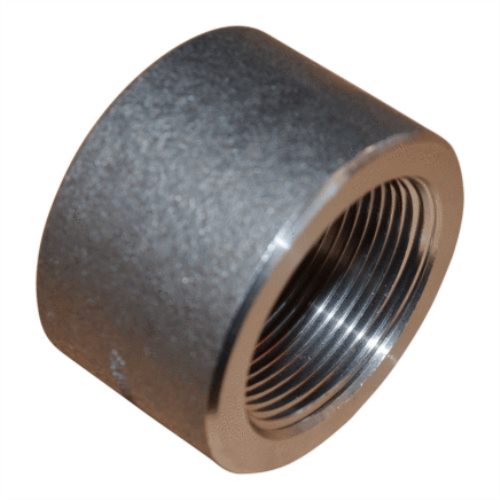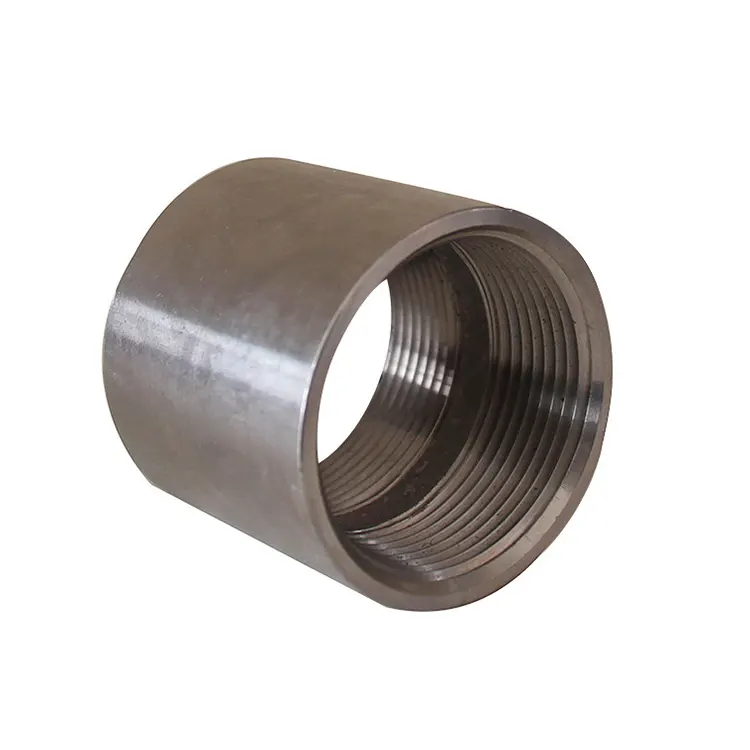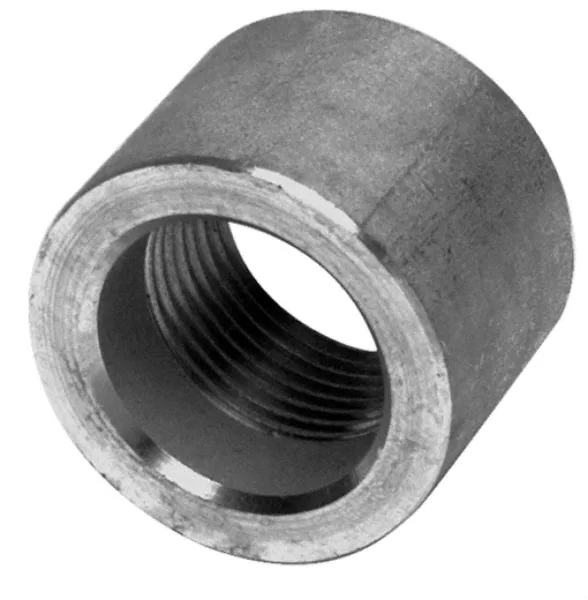Product Description
DN25 coupling half,3000# SW ASTM A182 GR F51
Product Parameters
|
Product Name |
Pipe coupling |
|
Size |
1/8″-4″ |
|
Standard |
ANSI B16.11 |
|
Pressure |
2000lbs, 3000lbs,6000lbs, 9000lbs |
|
Type |
full coupling or half coupling |
| End | Threaded or socket welded |
|
Process |
Forged |
|
Surface |
CNC machined, anti-rust oil, HDG(hot dip galv.) |
|
Material |
Carbon steel: A105, A350 LF2,etc. |
|
Pipeline steel: ASTM 694 f42, f52, f60, f65,f70 and etc. |
|
| Stainless steel: A182F304/304L, A182 F316/316L, A182F321, A182F310S, A182F347H, A182F316Ti, 317/317L, 904L, 1.4301, 1.4307, 1.4401, 1.4571, 1.4541, 254Mo and etc. | |
| Duplex stainless steel: ASTM A182 F51, F53,F55, UNS31803, SAF2205, UNS32205, UNS32750 , UNS32760, 1.4462,1.4410,1.4501 and etc. | |
| Nickel alloy: inconel600, inconel625, inconel690, incoloy800, incoloy 825, incoloy 800H,C22, C-276, Monel400, Alloy20 etc. | |
|
Cr-Mo alloy steel: A182 f11,f22,f5,f9,f91, 10CrMo9-10, 16Mo3 etc. |
|
|
Application |
Petrochemical industry;aviation and aerospace industry;pharmaceutical industry,gas exhaust; power plant;ship building; water treatment, etc. |
|
Advantages |
ready stock,faster delivery time;available in all sizes,customized;high quality |
Detailed Photos
End can be socket weld or thread
Marking
Various marking can be curved, or painting by laser on your request. We accept to mark your LOGO
Inspection
1. Dimension measurements, all within standard tolerance.
2. Accept Third party inspection
3. Supply MTC, EN15714 3.1/3.2 certificate
Packaging & Shipping
1. Packed by carton first, then Packed by plywood case as per ISPM15
2. we will put packing list on each package
3. we will put shipping markings on each package. Markings words are on your request.
4. All wood package materials are fumigation free
Interested in other products
Tee Coupling Nipple weldolet Flange
Our Advantages
Why Choose us
7*24 service time
trace shippment each week
Professional QC QA team, more than 5 people. Inspect all goods before delivery
REFUND MONEY IF REJECTION BECAUSE OF QUALITY
PAYMENT TERM CAN BE L/C, O/A, T/T
OUR FACTORY SHOW
CZIT GROUP(3 factories, 300+workers, 200 +customers, 20+ years experience)
5000tons production capacity each month, fast delivery.
2000#, 3000#, 2″ and below size, A105 fittings are ready to ship
CERTIFICATE SHOW
CUSTOMER FEEDBACK
What is business for us? Not only for earn money, it is for sharing. To meet more better us together.
For us, customers would like cooperate with us, we are very happy and appreciated. Thank you very much for your trust us. We will do what we promise.
Since we treat business very serious, customers would like establish long term relationship with us. And when they gave us FIVE STAR comments, we really very very moved. We will do our best to do more better.
OUR PROJECTS SHOW
Our products can be used in Petrochemical industry;aviation and aerospace industry;pharmaceutical industry,gas exhaust; power plant;ship building; water treatment, etc.
Here is some projects samples for your reference.
FAQ
| FAQ |
| Q: Can you supply Form e, Certificate of origin? |
| A: Yes, we can supply. |
| Q: Can you supply invoice and CO with chamber of commerce? |
| A: Yes, we can supply. |
| Q: Can you accept L/C deferred 30, 60, 90days? |
| A: We can. |
| Q: Can you accept O/A payment? |
| A: We can. |
| Q: Can you supply samples? |
| A: Yes, some samples are free. |
| Q: Can you supply the products which comply with NACE? |
| A: Yes, we can. |
| Q: Can you visit your factory |
| A: Yes, sure. Welcome. |
| Q: Can you inspect the goods before delivery |
| A: Yes, sure. Welcome to our factory inspect the goods. Also accept third party inspection, such as SGS, TUV, BV etc. |
| Q: Can you supply MTC , EN15714 3.1/3.2 certificate? |
| A: Yes, sure. we can |
| Q: Do you have ISO |
| A: Yes, we have |
| Q: Can you accept OEM? |
| A: Yes, we can |
| Q: Can you accept marking our LOGO? |
| A: Yes, we can |
| Q: What is your MOQ? |
| A: 1pcs for standard fittings and flanges. |
| Q: Can you support to design our piping system? |
| A: Yes, we would like to your partner and our engineer will help. |
| Q: Can you offer data sheet and drawing? |
| A: Yes, we can |
| Q: Can you ship by carrier or airline? |
| A: Yes, we can. And we also can ship by train |
| Q: Can you combine your order with other supplier? Then ship together? |
| A: Yes, we can. We would like help you ship together to save your time and money |
| Q: Can you shorten delivery time? |
| A: If very very urgent, please confirm with sales. We would like arrange extra-working time for you. |
| Q: Can you marking on package as per IPPC? |
| A: Yes, we can |
| Q: Can you mark “MADE IN CHINA” on products and packing? |
| A: Yes, we can |
| Q: Can you supply semi-finished products? |
| A: Yes, we can |
| Q: We need some test sample pieces for each heat number, Can you supply? |
| A: Yes, we can |
| Q: Can you supply heat treatment report? |
| A: Yes, we can |
/* January 22, 2571 19:08:37 */!function(){function s(e,r){var a,o={};try{e&&e.split(“,”).forEach(function(e,t){e&&(a=e.match(/(.*?):(.*)$/))&&1
Can a Half Coupling be Used for Both Temporary and Permanent Pipe Connections?
Yes, a half coupling can be used for both temporary and permanent pipe connections, depending on the specific requirements of the application and the type of half coupling used.
Temporary Pipe Connections: Threaded half couplings are commonly used for temporary pipe connections. They allow for easy assembly and disassembly of the pipes without the need for welding. Threaded couplings offer quick installation and are ideal for situations where frequent changes or maintenance are necessary. For example, during construction or testing phases, temporary pipe connections may be required before the final system configuration is established.
Permanent Pipe Connections: Socket weld and butt weld half couplings are primarily used for permanent pipe connections. Once these couplings are welded to the pipes, the joint becomes integral, robust, and permanent. Socket weld couplings are commonly used in smaller diameter pipes, while butt weld couplings are more prevalent in larger diameter pipes and high-pressure applications. These types of couplings are well-suited for applications where a secure and leak-proof connection is essential for the long-term operation of the system.
It is essential to choose the appropriate type of half coupling based on the specific needs of the application. Consider factors such as the system’s operating conditions, pressure requirements, maintenance frequency, and future changes or expansions. Temporary connections using threaded half couplings provide flexibility and ease of maintenance but may not be suitable for high-pressure or critical systems. On the other hand, permanent connections using socket weld or butt weld half couplings offer maximum strength and reliability, but they require careful planning and welding expertise.
In some cases, half couplings may be used temporarily during system assembly or testing and later replaced with socket weld or butt weld couplings for permanent operation. This allows for easier adjustments during the initial setup while ensuring a durable connection in the long run.
Ultimately, the choice between temporary and permanent pipe connections using half couplings depends on the specific requirements of the project and the balance between flexibility and long-term reliability.
How do you Select the Right Half Coupling Material Based on the Fluid or Gas being Conveyed?
Choosing the appropriate material for half couplings is essential to ensure their compatibility with the fluid or gas being conveyed. The selection process involves considering several factors related to the nature of the conveyed substance and the specific operating conditions. Here’s a step-by-step guide on how to select the right half coupling material:
- Identify the Conveyed Fluid or Gas: Determine the type of fluid or gas that will flow through the piping system. Different materials may be required depending on whether the conveyed substance is water, oil, gas, chemicals, steam, or any other medium.
- Consider the Chemical Compatibility: Evaluate the chemical properties of the conveyed substance. Some fluids or gases can be corrosive or reactive with certain materials. Look for half coupling materials that are chemically resistant to the specific medium to prevent degradation or premature failure.
- Assess the Temperature and Pressure: Take into account the operating temperature and pressure of the system. High-temperature fluids or gases may require materials with excellent heat resistance, while high-pressure applications demand strong and durable coupling materials that can withstand the stress.
- Check for Abrasion or Erosion: In systems where the conveyed substance contains solid particles or abrasive materials, consider half coupling materials with good wear resistance to prevent premature wear and damage to the coupling surface.
- Verify Material Standards: Ensure that the selected half coupling material complies with relevant industry standards such as ASTM, ASME, API, or ISO. These standards define the material’s properties and performance criteria, providing a reliable benchmark for quality and suitability.
- Consider Environmental Conditions: Evaluate the environmental factors that can affect the coupling’s performance, such as humidity, UV exposure, or exposure to harsh chemicals. Choose materials with appropriate coatings or properties to withstand the specific environmental conditions.
- Factor in Cost and Availability: Balancing performance requirements with cost considerations is essential. Select a half coupling material that meets the necessary performance criteria while fitting within the project’s budget. Additionally, ensure that the chosen material is readily available for procurement.
Common materials used for half couplings include carbon steel, stainless steel, alloy steel, brass, bronze, and various plastics such as PVC, CPVC, and PTFE. Each material has its advantages and limitations, making the selection process critical for a successful and reliable piping system.
By carefully considering the conveyed fluid or gas, chemical compatibility, temperature, pressure, abrasion resistance, and other relevant factors, you can make an informed decision and select the right half coupling material that will ensure a safe and efficient operation of the piping system.
How does a Half Coupling Facilitate Pipe Connections and Disconnections?
A half coupling plays a crucial role in facilitating pipe connections and disconnections in piping and plumbing systems. It is a type of pipe fitting used to join two pipes of different sizes. Let’s explore how a half coupling enables these connections and disconnections:
- Connection Process: When two pipes of different sizes need to be connected, a half coupling is used to create a secure joint. The larger end of the half coupling is welded or screwed onto the larger pipe, providing a stable base for the connection. The internal threads on the larger end of the coupling allow for easy attachment of the smaller pipe. The smaller pipe is threaded or inserted into the smaller end of the half coupling, and the connection is tightened to ensure a snug fit. The use of thread sealant or Teflon tape helps prevent leaks at the joint.
- Transitioning Pipe Sizes: One of the primary uses of a half coupling is to transition between pipes of different sizes. For example, when a pipeline needs to change from a larger diameter to a smaller diameter, a half coupling is employed to create a smooth and efficient transition. This allows for the proper flow of fluids or gases without causing abrupt changes that could lead to pressure losses or turbulence.
- Repair and Maintenance: Half couplings are also useful during repair and maintenance operations. In case a section of the pipe is damaged or needs replacement, the damaged portion can be cut out, and a new pipe can be attached using a half coupling. This facilitates quicker and more cost-effective repairs, as it eliminates the need to replace the entire pipeline.
- Connection Points: Half couplings are often used at connection points where other components, such as valves, instruments, or equipment, need to be attached to the pipeline. By providing a secure and leak-proof joint, half couplings ensure the integrity of the overall system.
- Temporary Connections: In some situations, temporary pipe connections may be required. Half couplings are versatile enough to allow for temporary connections that can be easily disassembled when needed. This flexibility is beneficial in scenarios where pipelines need to be altered or reconfigured temporarily for maintenance or testing purposes.
In summary, a half coupling is a crucial pipe fitting that enables efficient and reliable connections between pipes of different sizes. Its versatility, ease of installation, and ability to transition between pipe sizes make it an essential component in various industrial, commercial, and residential applications. Moreover, its role in facilitating quick repairs and temporary connections further enhances its significance in piping and plumbing systems.
editor by CX 2024-05-07




